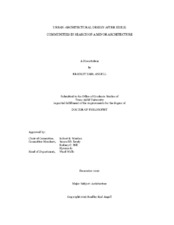| dc.description.abstract | This dissertation analogically applies a framework of minor literary analysis to uniquely political units of the built environment. As urbanism is conventionally understood to be executed per the greatest utility of established communal objectives, an underlying politicization is inherent as such forms must adhere to dominant norms of development which potentially marginalize those who practice cultural methods outside normative standards. Employing a uniquely architectural method of environmental justice advocacy, select communities facing disenfranchisement react by self-producing urban-architectural forms ("UAFs") to protect threatened cultural values from marginalization. Installed to subvert the existing power dynamic, such UAFs are potential exhibitions of minor architecture.
Adopting the analytical standards established by Gilles Deleuze and Felix Guattari for evaluating Franz Kafka's literature, this paper tests six UAFs to discover if a minor architecture is possible under contemporary globalization. Employing an enumerated framework of minor production characteristics, an interpretive-historical analysis is the primary method of judgment regarding each unit's execution of minor architecture. Two secondary tests are undertaken to validate the primary findings, the first of which is a physio-logical evaluation that characterizes and measures urban resource utility as per collective minority aims. Second, a newspaper correlation test is undertaken so as to judge the enunciative effectiveness of each community per issues of minority politics.
Of the six cases examined, two have their source in cinema including "Bartertown" of MAD MAX BEYOND THUNDERDOME (1985) and the "House on Paper Street" of FIGHT CLUB (1999). The four remaining cases include the Tibetan Government-in-Exile of Dharamsala, India; Student Bonfire of Robertson County, Texas; Isla Vista Recreation & Park District of Santa Barbara County, California; and the Emergent Cannabis Community of Arcata, California. Of all the cases studied, only the Tibetan Government-in-Exile met both the conditions of minor architecture and was validated in terms of practiced urban resource use as well as effective representation in mainstream newsprint. Both cinematic cases failed as minor productions of the built environment. Although they did not find full validation, the three remaining real-world UAFs each were found on a course of minor architectural expression at varying stages of execution. | en |


